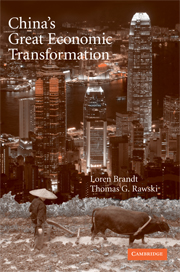Book contents
- Frontmatter
- Contents
- List of Figures
- List of Tables
- Contributors
- Acknowledgments
- Map
- 1 China's Great Economic Transformation
- 2 China and Development Economics
- 3 China in Light of the Performance of the Transition Economies
- 4 A Political Economy of China's Economic Transition
- 5 The Demographic Factor in China's Transition
- 6 The Chinese Labor Market in the Reform Era
- 7 Education in the Reform Era
- 8 Environmental Resources and Economic Growth
- 9 Science and Technology in China
- 10 The Political Economy of Private Sector Development in China
- 11 The Role of Law in China's Economic Development
- 12 China's Fiscal System: A Work in Progress
- 13 Agriculture in China's Development: Past Disappointments, Recent Successes, and Future Challenges
- 14 China's Financial System: Past, Present, and Future
- 15 China's Industrial Development
- 16 China's Embrace of Globalization
- 17 Growth and Structural Transformation in China
- 18 Income Inequality during China's Economic Transition
- 19 Spatial Dimensions of Chinese Economic Development
- 20 Forecasting China's Economic Growth to 2025
- Index
18 - Income Inequality during China's Economic Transition
Published online by Cambridge University Press: 24 May 2010
- Frontmatter
- Contents
- List of Figures
- List of Tables
- Contributors
- Acknowledgments
- Map
- 1 China's Great Economic Transformation
- 2 China and Development Economics
- 3 China in Light of the Performance of the Transition Economies
- 4 A Political Economy of China's Economic Transition
- 5 The Demographic Factor in China's Transition
- 6 The Chinese Labor Market in the Reform Era
- 7 Education in the Reform Era
- 8 Environmental Resources and Economic Growth
- 9 Science and Technology in China
- 10 The Political Economy of Private Sector Development in China
- 11 The Role of Law in China's Economic Development
- 12 China's Fiscal System: A Work in Progress
- 13 Agriculture in China's Development: Past Disappointments, Recent Successes, and Future Challenges
- 14 China's Financial System: Past, Present, and Future
- 15 China's Industrial Development
- 16 China's Embrace of Globalization
- 17 Growth and Structural Transformation in China
- 18 Income Inequality during China's Economic Transition
- 19 Spatial Dimensions of Chinese Economic Development
- 20 Forecasting China's Economic Growth to 2025
- Index
Summary
INTRODUCTION
The primary motivation for China's economic reforms was to increase economic growth and raise living standards after nearly twenty years of stagnation. Given the move to more market-based income determination, the reforms had the potential to conflict with inherited egalitarian-motivated socialist institutions and rhetoric. To what extent have the reforms led to widening inequality? Who have been the winners and losers? Have the reductions in poverty that accompanied growth been sufficient to alleviate concerns over inequality? Do increases in inequality threaten the long-run sustainability of the reforms? Are there identifiable patterns in the evolution of the income distribution that suggest potential policy responses?
The objective of this chapter is to document the evolution of inequality, and the income distribution more generally, during the reform period and where possible to draw conclusions concerning the role that transition has played in increasing inequality. The centerpiece of our chapter is the assembly of three cross-section data sets that allow a relatively consistent calculation of inequality from the mid-1980s onward. It turns out that establishing “first-order” facts about Chinese inequality is quite difficult and that conclusions hinge on mundane (but important) issues of measurement and data quality. In this regard, it is unfortunate that much of the household-level survey data collected annually by China's National Bureau of Statistics (NBS) remains outside the public domain.
- Type
- Chapter
- Information
- China's Great Economic Transformation , pp. 729 - 775Publisher: Cambridge University PressPrint publication year: 2008
- 34
- Cited by



